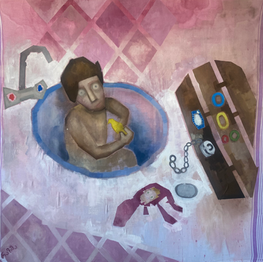Nini Razmadze
Nini Razmadze is a Georgian artist based in Tbilisi. She studies painting at the Tbilisi State Academy of Arts. Her work is rooted in the exploration of memory, absence, and emotional truth, themes that have defined her practice from the beginning. Early in her studies, Razmadze was confronted with the realization that she could not clearly remember her own childhood. This shocking discovery deeply affected her and became a defining moment in her artistic journey. Believing that the best way to begin remembering and to piece together her fragmented past was through painting, she turned her practice into a process of searching, reconstructing, and stitching together what was lost. Her works often combine painting with mixed media, including fabric, paper, and found textures, to create surfaces that feel fragile yet layered. This approach mirrors the instability of memory and the way personal history is built from both truth and invention. Each piece becomes a reconstruction of moments that are not fully accessible, blending what may be remembered with what is imagined. Through this process, Razmadze has developed a practice that is both deeply personal and quietly universal. Her paintings are not only attempts to recover her own past, but also invitations for viewers to reflect on their own hidden narratives, silences, and distortions of memory. At just 20 years old, she is shaping a distinct artistic voice that transforms forgetting into a form of storytelling, where absence itself becomes material for creation.
Statement
The struggle to remember those formative years has become a central theme in my creative journey. This longing to re-connect with my past drives me to capture fleeting moments fragments of memory that resurface like whispers from the edges of my mind. I paint what I can remember: a passing image, a forgotten feeling, or even the stories my relatives shared about those early days. Each piece is an exploration of memory fragile and fragmented nature, an attempt to bridge the gap between what was, what is remembered, and what might have been. Through my work, I aim to preserve the intangible and give form to what fades. One particular painting, for example, was born from a hazy memory of a moment when I poured soup on my own head. I was a child, sitting on the balcony of my childhood home. My mother had told me that if I didn’t finish my food, she would pour it on me so I took the bowl and did it myself. Itís a moment that feels both absurd and emotionally charged, unclear yet strangely vivid. These are the kinds of fragmented stories that inform my process: real or imagined, they hold emotional truth. Each piece is an attempt to reconstruct the narrative of my childhood by blending what is remembered, what is imagined, and what is retold. My process is one of preservation: capturing the intangible, stitching together fragments, and confronting the spaces where memory falters. Ultimately, my work is not just about remembering it’s about embracing the beauty of the incomplete. It’s a journey to find meaning in the gaps and to celebrate the imperfect ways we hold on to the past.












